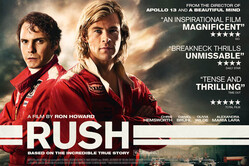 The first thing to say about Rush is that it is the best motor racing movie ever made. The racing sequences are outstanding and Chris Hemsworth and Daniel Bruhl are James Hunt and Niki Lauda to the life, they are uncanny in appearance, mannerisms and voice.
The first thing to say about Rush is that it is the best motor racing movie ever made. The racing sequences are outstanding and Chris Hemsworth and Daniel Bruhl are James Hunt and Niki Lauda to the life, they are uncanny in appearance, mannerisms and voice.
The significance of the 1976 season is not only that it was a great human story, with Niki being given the last rites and racing six weeks later, in considerable pain. It was a story which captured the public's imagination and elevated Formula One from a minority sport into the mainstream. Full television coverage followed in 1978, largely a result of the Hunt/Lauda battle.
All Pitpass readers will know the general story, but not all lived through 1976. Director, Ron Howard has caught the period precisely, the pits and the paddock are how they were. Everything was much more informal than today. There were far fewer mechanics and engineers. There was no pit to car radio or banks of computers. Nobody then had thought of using computers, the first instance came a couple of years later when Karl Kempf was employed by Ken Tyrrell.
The sport was dangerous, safety harnesses had only become mandatory in 1972. There was no crash testing, drivers relied on their designers and they worked, often alone, with pencils and slide rules. The film emphasises the danger not to be sensational, but to remind a modern audience how things were.
You had these contrasting personalities and this is the meat of the film. In fact, James and Niki were friends off the track. James was the great babe magnet and Niki picked up the collateral. Niki stayed in James's flat in London. Rush, however, is a drama, not a documentary and drama needs conflict. The script takes liberties with the literal truth to serve a greater end.
Richard III never said, 'A horse, a horse, my kingdom for a horse', but the cry encapsulates Richard's desperation. Within six years of Shakespeare writing that, the verse satirist, John Marston, began a section of a long poem with, 'A man, a man, my kingdom for a man.' Shakespeare wrote a drama, not a documentary. A dramatist is allowed to take liberties with details to serve the bigger picture.
James Hunt did win the 'Driver of the Year' trophy awarded by the Guild of Motoring Writers. The movie suggests that it was in 1970 when it was in 1973 after James had raced a private March in some F1 races, a season missing from the film. The Guild's dinner is shown filled with glamorous women, as a Guild member, I wish. It is for members only, not their spouses. I know that, fellow members know that and so do guests from manufacturers who look after hacks.
The award is not that important, few members of the Guild have expert knowledge of motor racing, they are more concerned with the motor industry and the latest Korean import. I have only ever voted once.
None of that matters, it's a drama on film. This detail merely goes to show James emerged from being 'Hunt the shunt', he was pretty wild, to being a respected driver.
Of course, there are going to be geeks who pick up on minor details, which they will inevitably call 'mistakes'. They do this to make themselves appear more important, and more knowledgeable than they are. A geek is only a geek, unless he is also a nerd.
It is clear that the final version of Rush has been subjected to editing. An actor portrayed Stirling Moss, he is in the credits, but his performance ended on the cutting room floor. In a better world the editor would be burned at the stake for blasphemy for cutting Sir God, even represented by a mere player.
More seriously, after James's McLaren was disqualified from victory in Spain (it caused a furore in England) McLaren modified the M23 and moved the oil cooler. That simple act upset the aerodynamic balance and James was uncompetitive for a spell. We hear about the oil cooler, but not about the aerodynamic balance, or how McLaren solved the problem. That is down to the editor who was probably under pressure to make the movie a certain length.
Cinemas make their money by so many screenings per day and the opportunity to sell popcorn (it doesn't make a noise) and ice cubes mixed with cola.
Aerodynamics were not well understood in 1976, the McLaren was never in a wind tunnel, that sort of testing arrived a couple of years later. Among other things, the 1976 season was on the cusp of technical development. McLaren had a vague idea that under-car airflow was important, but had not worked out why.
At Lotus, Peter Wright was working on the problem and the last race of 1976, when Hunt secured the title, was won by Mario Andretti in a Lotus employing ground effect.






















sign in